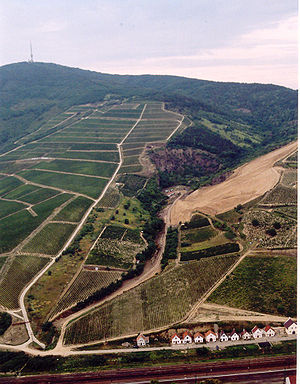Tokaj wine region
| Wine region | |
 |
|
| Country | Hungary, Slovakia |
|---|---|
| Total area | 11,149 ha |
| Size of planted vineyards | 5,500 ha |
| Grapes produced | Furmint, Hárslevelű, Yellow Muscat, Zéta, Kövérszőlő, Kabar |
| Varietals produced | Tokaji |
 |
|
| UNESCO World Heritage Site | |
|---|---|
| Location |
Hungary |
| Criteria | iii, v |
| Reference | 1063 |
| Coordinates | 48°09′N 21°21′E / 48.15°N 21.35°E |
| Inscription | 2002 (26th Session) |
|
[]
|
|
Tokaj wine region (Hungarian: Tokaji borvidékSlovak: Vinohradnícka oblasť Tokaj) or Tokaj-Hegyalja wine region (short Tokaj-Hegyalja or Hegyalja) is a historical wine region located in northeastern Hungary and southeastern Slovakia. It is also one of the seven larger wine regions of Hungary (Hungarian: Tokaji borrégió). Hegyalja means "foothills" in Hungarian, and this was the original name of the region.
The region consists of 28 named villages and 11,149 hectares of classified vineyards, of which an estimated 5,500 are currently planted. Tokaj has been declared a World Heritage Site in 2002 under the name Tokaj Wine Region Historic Cultural Landscape. However, its fame long predated this distinction because it is the origin of Tokaji aszú wine, the world's oldest botrytized wine.
Due to the Treaty of Trianon, a smaller part of the historical wine region now belongs to Slovakia.
Some of the characteristics which make the Tokaj wine region unique are:
No one knows when the first wines were made in the Tokaj region. Historical records show that vineyards had been established in Tokaj as early as the 12th century. There is evidence for the earlier introduction of wine production to the region, but opinion is divided on when this occurred.
A number of experts claim that viticulture could have started in the Tokaj region as early as in the Celtic times, that is BC. A petrified grape leaf found in Erdőbénye and dating from the late 3rd century AD, points to the existence of viticulture in Roman times. Slavs arrived in the region in the late 5th/early 6th century. One possible origin for the name "Tokaj" is that it is derived from the Slavic word "Stokaj", meaning approximately confluence (i.e. confluence of the rivers Bodrog and Tisza). The Slovaks claim that Slavs continued previous viticulture in the region.Magyar settlers arrived in Tokaj from the end of the 9th Century and there is an alternative theory that viticulture was introduced to the region from the east, possibly by the Kabar tribe. The Magyars themselves seem to have had an ancient tradition of wine-making (see: Origins of Hungarian wine-making). Another possible origin for the name "Tokaj" is that it comes from an Armenian word meaning "grape".
...
Wikipedia

